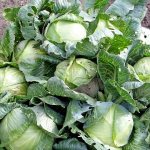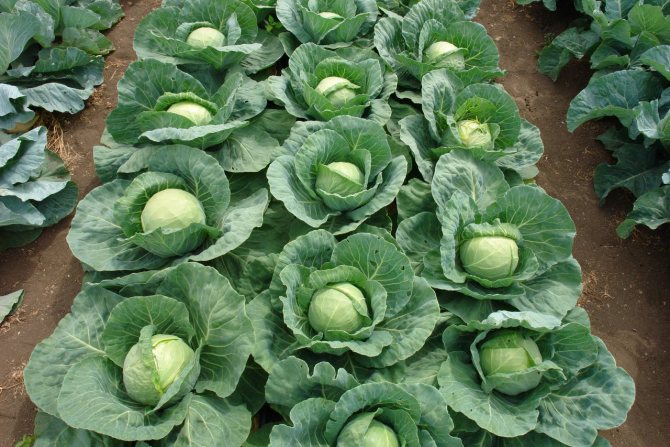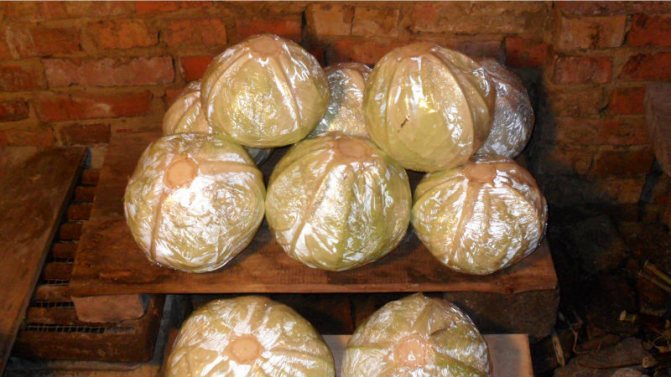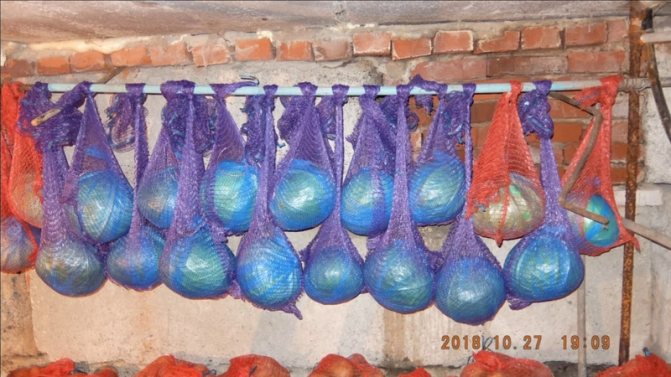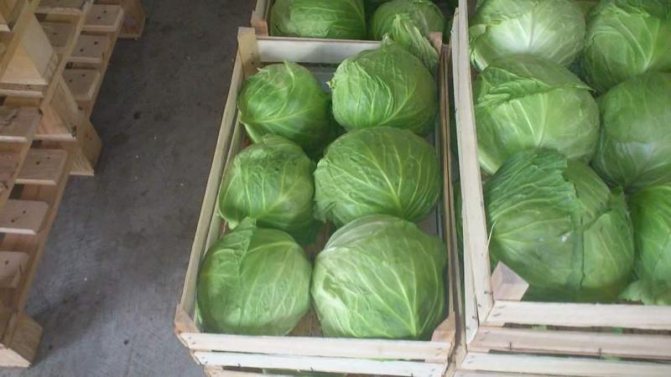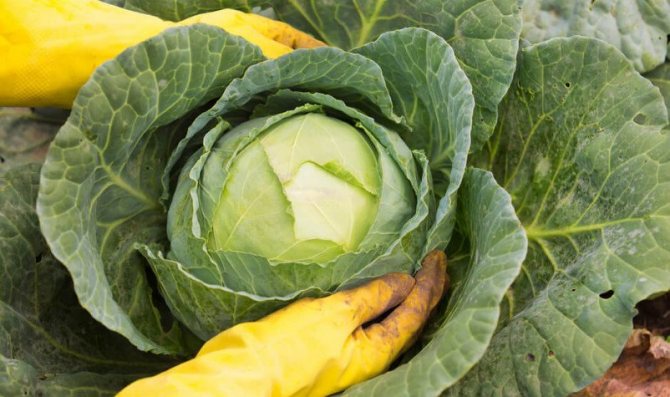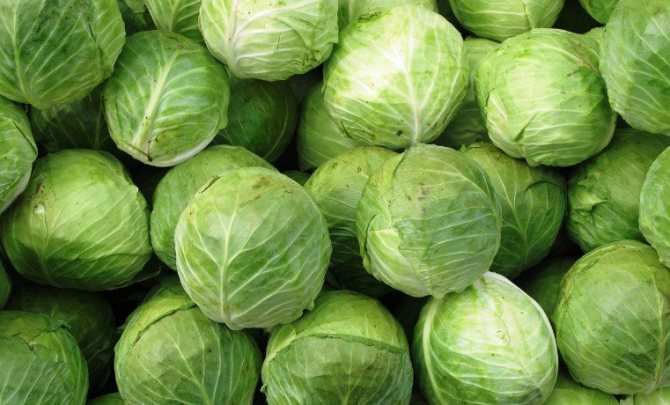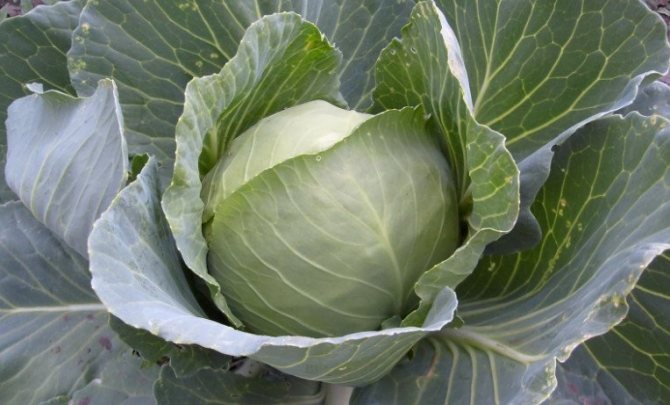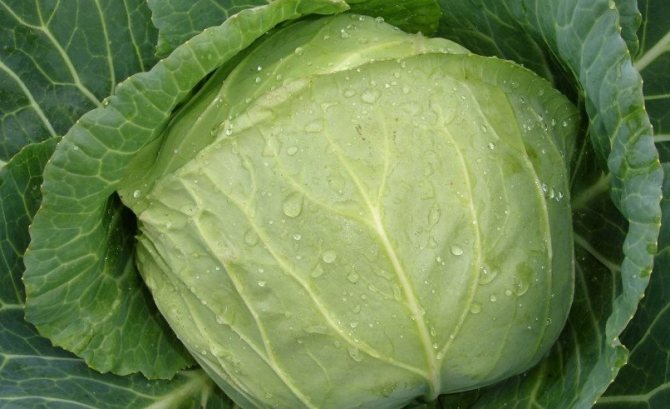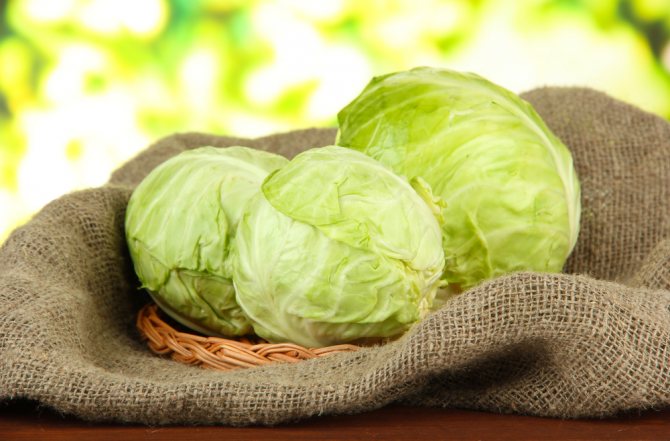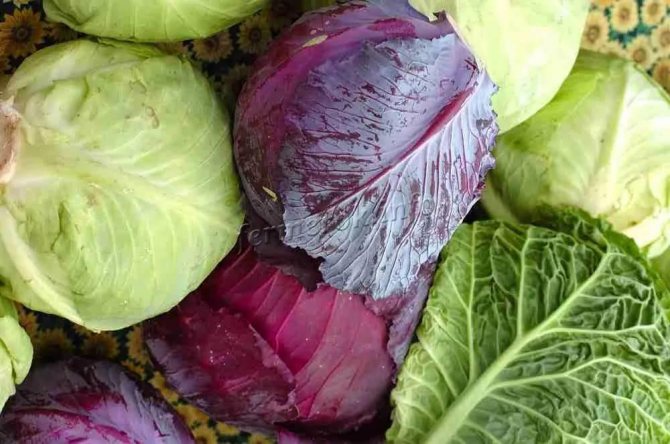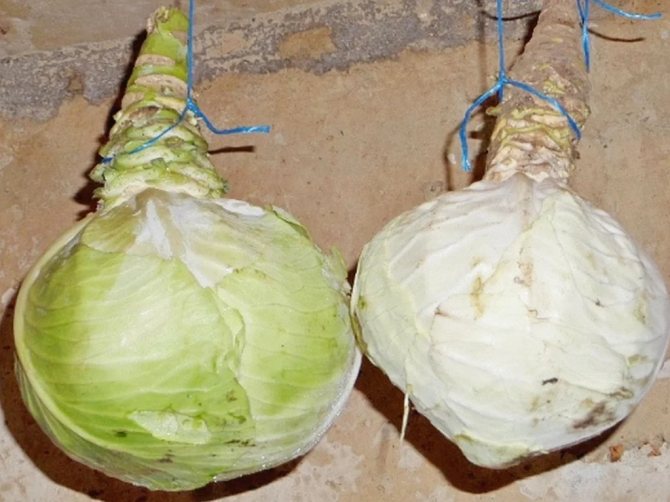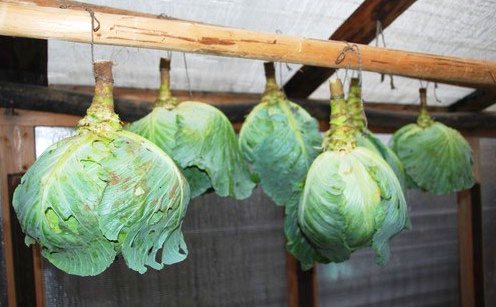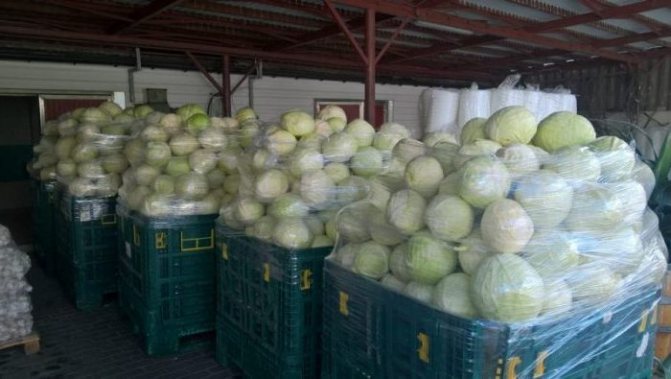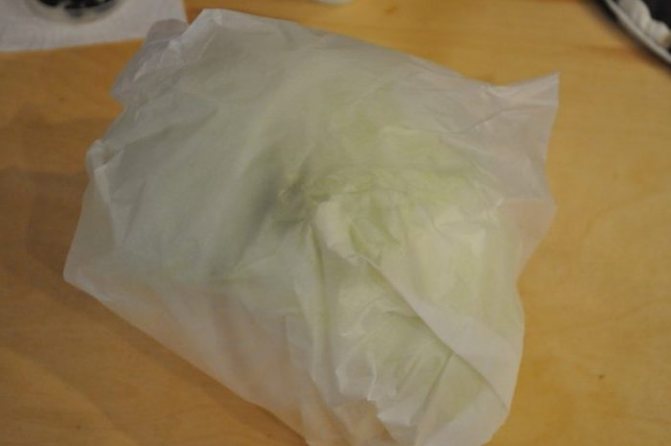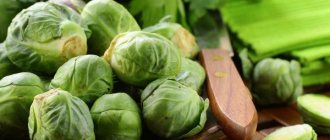Cabbage is one of the most popular types of vegetables that gardeners grow (outdoors) in their summer cottages. With proper agricultural technology, you can get a bountiful harvest of cabbages, which every summer resident wants to save until spring. That is why the issues of proper storage of cabbage in winter are of concern to many.
Types and varieties of cabbage suitable for long-term storage
First of all, you need to remember that only medium-late and late varieties are suitable for storage. It is better to remove them after the first frost. They can withstand temperatures down to 5-6 ° C below zero. Subzero temperatures contribute to the accumulation of sugar in the heads of cabbage, which makes the vegetable only tastier.

For storage, choose mid-ripening and late-ripening varieties
Cabbage varieties and hybrids, growing / storage periods:
| Cabbage variety or hybrid | Growing period (days) | Shelf life (months) |
| "Aggressor" | 120 | 5 |
| "Mara" | 165 | 8 |
| "Moscow late 9" | 130 | 9 |
| "Guarantor F1" | 140 | 6 |
| "Amager 611" | 160 | 6 |
| "Megaton" | 130 | 5 |
| "Valentina" | 180 | 8 |
| "Arctic F1" | 130 | 5 |
| "Kolobok" | 150 | 7 |
| "Sugarloaf" | 160 | 8 |
| "Lezhky" | 155 | 9 |
| "Megaton F1" | 140 | 6 |
There are also varieties:
- "Blizzard" with a shelf life of up to 6-7 months;
- "Sibiryachka" - shelf life up to 4 months;
- "Leader" - if properly stored, the heads of cabbage lie until March;
- "Extra F1" - this cabbage has a shelf life of up to 7 months;
- "Three heroes" - this variety is stored for up to 8 months;
- "Wintering", "Snow White" and many others.
Nowadays, all new varieties and hybrids appear on the seed market, and which one to choose depends only on the wishes and preferences of the gardener. Some housewives buy old, time-tested varieties, others experiment with new ones. The latter make it possible to grow vegetables more resistant to diseases. You can pick up seeds that are adapted to certain climatic conditions, different terms of germination and degrees of frost resistance.
What can and cannot be together?
In the cellar, along with the cabbage, other vegetables that are grown in season are also stored. Is it possible to store heads of cabbage in such conditions?
If it is not possible to divide vegetables into separate rooms, you must adhere to a number of rules.
"Neighbors" for a vegetable are:
- beet;
- carrot;
- potatoes and other vegetables.
Neighborhood rules:
- Disease-infected vegetables are not stored with healthy vegetables.
- Cabbage should not be mixed with other vegetables.
- It is advisable to maintain a distance between the heads of cabbage.
- Apples and pears should not be placed near cabbage, as they, due to the release of ethylene, stimulate the ripening of vegetables and fruits nearby.
- When stored with cabbage tomatoes, their taste becomes worse.
Rules and conditions of storage, preparation of vegetables
Storing cabbage at home depends on the shape and structure of the head - you need to choose dense forks, loose ones will not be stored for a long time. The forks should be round, ideally slightly flattened on top. Such a comrade will best of all "survive" the winter and lie there until spring.
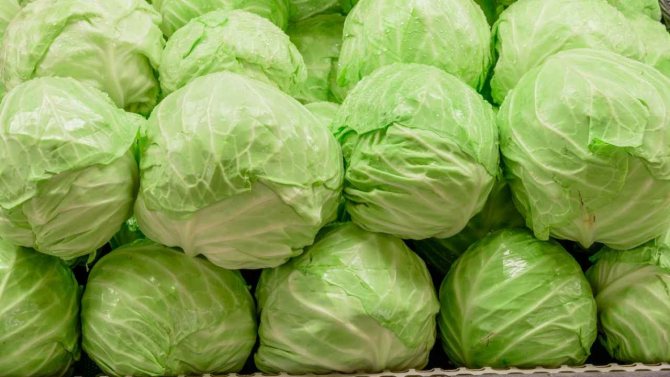

Dense, healthy heads of cabbage are suitable for storage.
Cracked, flabby, damaged, frozen heads of cabbage are not stored for storage. Such vegetables can become a source of rot for healthy and high-quality specimens nearby. It is better to recycle the rejected fruits immediately.
On a note! The crop harvested after the first frost is stored longer and better. The explanation is simple: at a low temperature, cabbage stops "breathing", as if it additionally preserves itself. But vegetables harvested before the onset of frost, at a temperature of 6-7 ° C above zero, will lie much less.
Optimum temperature for cleaning cabbage - when the morning frost is reached 2-3 ° C frost.
Important! Storage rooms should not be infected with mold or mildew. Heads of cabbage laid for the winter are the most "tasty" habitat for them!
In order not to be left without a crop, the cellar or basement must be prepared in advance for laying vegetables:
- First of all, thoroughly disinfect walls, ceilings and other surfaces using a lime solution with the addition of copper sulfate. There is a caveat: some types of rot can persist on glass jars with homemade blanks. And since few people keep the cabbage crop in a separate basement, the infection of heads of cabbage with rot can occur in a room with treated surfaces.
- Another way is to use sulfur. This will help not only to decontaminate the premises, but also to get rid of rodents - rats and mice, which, when cold weather approaches, flock to wintering closer to human housing, feeding not only on waste, but also destroying the harvest of vegetables in basements and cellars. Sulfur treatment must take place in a hermetically sealed room, otherwise it will not give the desired result. And you need to remember that the sulfur dioxide that is released during the combustion of a substance is poisonous to humans and pets.
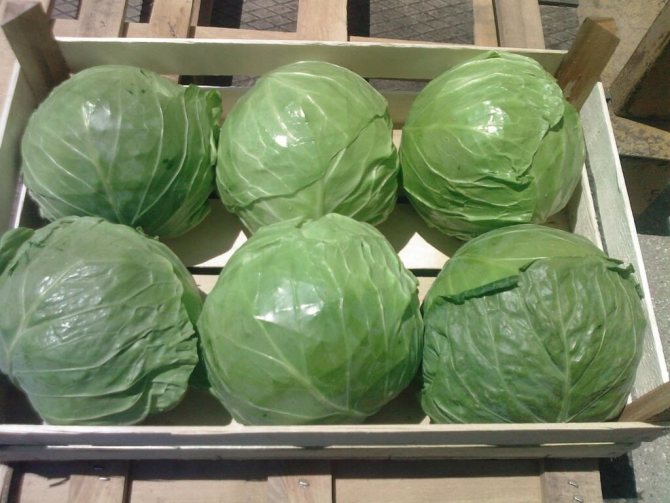

The optimal storage temperature for cabbage is from 0 to + 5 ° С
It is better to harvest cabbage in dry weather so that excess moisture evaporates. Additionally, keep the heads of cabbage in a warm, dry place for a couple of days. Make sure the stalks are dry. The length of the cabbage stem depends on the storage method.
Temperature, in which the cabbage heads are stored - from 0 to +5 degrees... At low temperatures, it will freeze slightly, which will negatively affect the taste and quality of vegetables.
Optimal humidity for storing heads of cabbage - from 80 to 90%... We need to remember about the "neighbors". If there are vegetables or fruits that emit ethylene (for example, apples) nearby, then the shelf life of cabbage will be significantly reduced, despite all efforts.
How to prepare cabbage for storage
In order for crispy cabbages not to lose their firmness and taste, they must be properly prepared for long-term storage.
Harvesting rules for long-term storage:
- Heads of cabbage are cut in dry weather. As soon as the cold snap begins, the temperature is set to 0 ... + 5 ° С - it's time to harvest.
- Heads of cabbage are cut off with a sharp knife. If the storage method requires a long stump, then dig it up by the root.
- Only 2-3 cover sheets are removed. The rest protect the head of cabbage from damage, penetration of bacteria.
- Heads of cabbage are sorted. For winter storage, strong forks are chosen that do not have signs of decay, mechanical damage, are not cracked, not frostbitten.
Storage in a cellar or basement
There must be ventilation in the cellar or basement. It will provide air circulation and remove excess moisture. Without ventilation, fungus and mold will surely appear on the walls of the basement, which will have a detrimental effect on the safety of the crop.
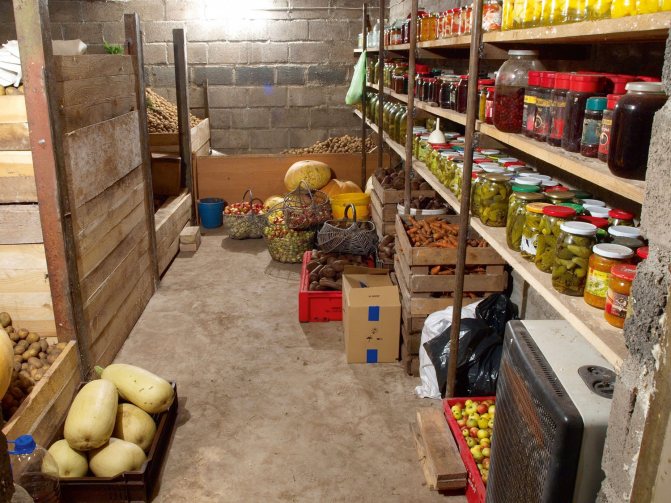

Equipped, clean basement or cellar - the key to the safety of your crop
To store cabbage in the cellar all winter, you need to protect the room from rodents. This will preserve the harvest and protect against diseases that are spread by "uninvited guests". Mice and rats do not so much destroy vegetables as damage and bite most of them.
Attention! Such vegetables should not be eaten, since animals are carriers of dangerous diseases, carriers of infections and helminths.
There are many options for storing cabbage in a cellar or basement. Everyone chooses the best way to preserve cabbage in winter, adapting with experience to the individual characteristics of the store.


Storing cabbage in a cellar or basement
An important factor is the availability of free time for the owner and hostess, since some methods of storing cabbage in the winter require periodic inspection of the harvest, set aside "in reserve". In any case, it is necessary to inspect the cabbage at least once a month.
In boxes and pallets
We clean the cabbage heads from the excess layer of leaves, cut off the stump and place them in prepared boxes or trays with the bottom down. It is better to store such cabbage, leaving two or three loose leaves on its clothes.
Note! The drawers should have ventilation holes, primarily from the bottom.
To do this, between the floor and the bottom of the container, you need to lay bars or make small "legs" for the boxes. This method requires attention and time. Since the heads of cabbage lie next to each other, you should periodically check them to remove rotten leaves or even dispose of spoiled forks.
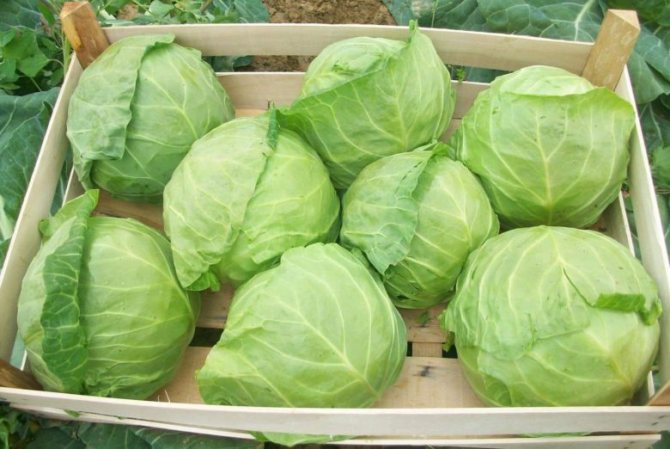

Heads of cabbage in boxes are placed with the stalk down
All boxes must be dried in advance, and also cleaned of the remnants of last year's harvest and treated with a disinfectant solution, for example, potassium permanganate.
On racks
The method is similar to storage in boxes and pallets, only less expensive. We put the prepared forks on the racks with the stump down and periodically check the safety of the crop. When stacking on racks, it is necessary to ensure that good ventilation of the heads of cabbage is maintained, otherwise rot and mold cannot be avoided.
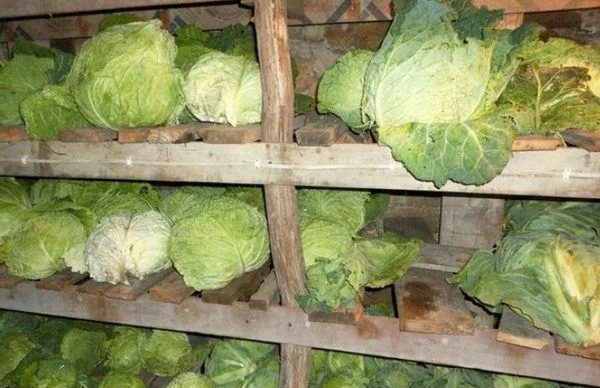

Storage of cabbage on shelves
You also need to make sure that the distance between the boards or slats on the shelves is about 5 centimeters, which ensures good air exchange. The wood of the shelving should also be well dried, cleaned and processed to avoid mold and rot infestation on the heads of cabbage.
In bulk pyramid
This is the least suitable method for storing cabbage - it will have to be sorted often. In order to preserve the heads of cabbage in this way in the cellar in winter, you need to prepare a ventilated surface on the basement floor, which will increase the chances of preserving the crop.
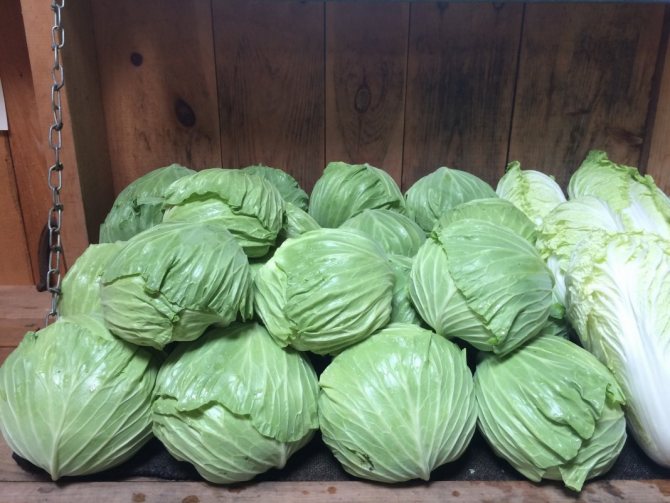

Cabbage pyramid
You can put coarse straw on the floor in a thick layer. You can also use fir branches or wooden slats. The main thing is not to allow contact with the floor of the cellar or basement. Then carefully lay out the cabbage in several rows with stumps down, after that we put the second and subsequent rows to make a "pyramid" of cabbages. Place straw or fir legs between the rows.
In sand and clay
To put cabbage in the sand, you will need containers: bags, baskets, other containers. The sand must be dry. We put the first layer of cabbage forks, cover with sand, then the next layer of cabbage, and again sand. This method will keep the cabbage in the cellar until spring.
Another way to use sand for storing crops in a cellar is to stick heads of cabbage with a long stump into wet sand as they grew in the ground. This will "extend the life" of your crop by several months.
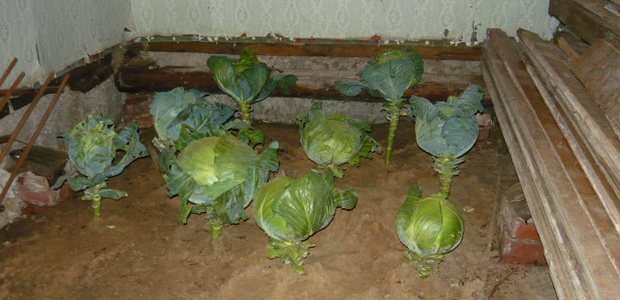

We plant heads of cabbage for the winter in the sand
Instead of sand, you can use soil or sawdust. For this type of cabbage storage, you can use any containers available on the farm: buckets, basins, baskets with dense weaving, boxes and boxes. If desired, you can even use plastic bags or bags, filling the selected filler.
Clay storage is a highly controversial solution. The point is that getting rid of clay is not so easy. Especially if you allow the top leaves to be eaten by pets.
How to store cabbage in clay?
- we dilute the clay in a ratio of 2 to 1 (two parts of clay to 1 part of water) to the consistency of sour cream;
- we dip the cabbage heads into the mixture from all sides;
- let dry and put away for storage.
On a rope under the ceiling
At the optimum temperature and humidity, this is the most ergonomic storage method. It can be seen which heads of cabbage began to deteriorate, which ones need to be removed from the leaves, and which ones should be consumed first.
We leave a few loose leaves on the plants (this will prevent the heads of cabbage from drying out), as well as a long stump. The second option is to hang the heads of cabbage by the roots, for this, during harvesting, do not cut them off, carefully shake them off the ground or wash them. We tie the cabbage forks in pairs, throw them over the outstretched poles or cling to the hooks on the ceiling beams.
In plastic bags
Prepared heads of cabbage with this method are folded into plastic bags or bags. They should have holes for ventilation. You also need to take care not to accumulate condensation, which can cause rotting of the covering leaves.
Important! This method requires special attention to the temperature regime if you store cabbage in bags in the cellar or basement. At high humidity, an increase in t can completely ruin or spoil the crop.
In paper or cling film
You can store cabbage wrapped in paper. Baking paper works best for this, newspapers are worst. We wrap the processed heads of cabbage with paper and put them in boxes or on racks so as to protect the paper from getting wet and damp.
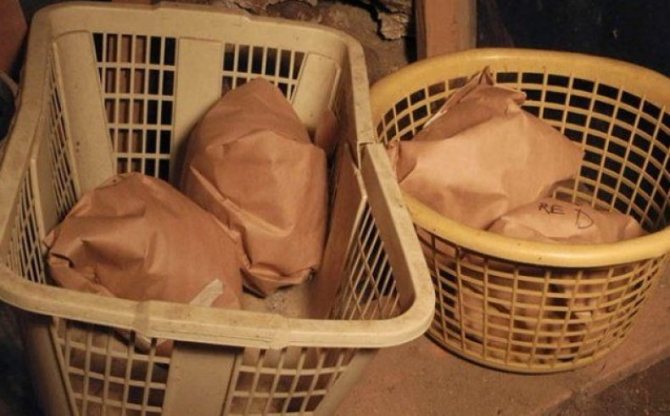

For storage in paper, choose a bakery, do not use newspapers
When storing in paper, in the future, it is necessary to ensure that the material remains dry, and when you see traces of wetting, you need to remove the old paper, cut off the damaged leaves and wrap the heads of cabbage again.
The method of storing cabbage in cling film is new, but has already proven itself well. For this method of harvesting cabbage for the winter, carefully prepare it. It is necessary to remove loose leaves, and cut off the stalk as short as possible. The maximum length is 5 centimeters, but it is better to cut it flush with the head of cabbage. The cut at the stalk must be dried.
This part of the stalk is needed for the subsequent storage of cabbage in boxes and on racks. Some gardeners use cling film to keep the forks moist. In this case, the stump remains long and is usually not wrapped with a film.
Note! When choosing cling film for wrapping cabbage, you should purchase a roll with a width of 350 - 450 mm. The vegetables are wrapped in 3-4 layers of film, smoothing tightly so that no voids remain. Heads of cabbage for this storage method should be very dense, as well as undamaged, clean, dry. It is not allowed to store cabbage affected by butterflies or slugs.


Only clean, dry and very tight forks can be stored in cling film.
If you have organized a place in the cellar for storing cabbage in cling film, you need to make sure that the polyethylene is tightly attached to the surface of the head of cabbage. Otherwise, condensation will appear, which will damage the vegetables. If you notice perspiration, remove the foil from the forks and wrap them again. Dry the surface so that no moisture remains on the leaves.
In cling film, cabbage can be stored both suspended from the ceiling and in boxes or on shelves.
Preparing the cellar for winter
Cabbage in the basement can be stored for a long time in winter if dampness is completely removed. Otherwise, the crop will begin to mold and rot. Storage is only permitted in a well-ventilated area. In the summertime, windows and doors should be opened to the basement. To eliminate moisture in the room, place boxes with salt, charcoal or absorbent.
Warehousing and storage of cabbage in a cellar in winter is incompatible with rot and mold.You can get rid of them with the help of special disinfectants. Such a procedure must be carried out without fail twice a year.
Mold on the walls of the basement is removed with a brush. Among the radical methods, special checkers and tablets are very popular: their acrid smoke gets rid of microorganisms. When working with them, a respirator is required. The checker is placed in a bucket, set on fire on the street and brought into the basement. The door is tightly locked so that a draft does not interfere with disinfection. It is strictly forbidden to be inside while the checker is burning.
It is interesting: what you need to get rid of mold in the cellar.
The method eliminates not only mold, but also mites and insects. The remaining smell will scare them away for a certain period of time.
It is possible to store cabbage in a subfield for a long time only if there are no mice and rodents. All cracks and channels through which animals can get inside should be sealed with cement. If necessary, metal grids are additionally installed.
To scare away rodents, naphthalene, black root and mint are used. These substances are placed around the perimeter of the basement. Rodents will eat harmful food and get poisoned. However, it should not be eaten by pets. More recently, an industrial rodent repeller has appeared on the market. It generates an ultrasonic signal that irritates them.
It is interesting: how to process a cellar from mice.
Storage in piles or trenches
This method is quite laborious and time-consuming, although not much material costs are required. It is convenient to store a large crop in piles if it needs to be preserved in its entirety until spring. Removing one or two heads of cabbage for consumption without the risk of losing the remaining crop is quite problematic.
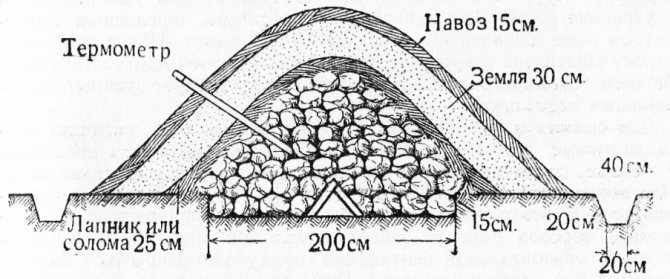

The construction of the pile
With this method, a layer of straw or sand is laid on the bottom of the prepared trench or pile, then several layers of cabbage, alternating it with straw or fir paws, are tamped on top with a thick layer of straw and earth cover.
The forks are stacked with stumps up, and the upper, loose leaves must be carefully tucked up. Be sure to arrange supply ventilation. When choosing a storage location in this way, you need to take into account that moisture from autumn rains can get into the trench.


It is very important to observe the correct temperature and humidity.
And also very closely monitor the temperature inside the pile. The trench should be placed on a hill so that the bottom of the shelter is not flooded by groundwater.
Helpful information
Tips for storing cabbage in film:
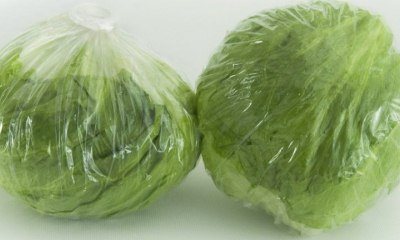

To simplify your task, you need to get a film, the width of which is 35-45 cm. If its size is larger or smaller, it will be inconvenient to wrap the heads of cabbage.- If a large amount of moisture has formed inside, the film must be removed, dried forks, inspected for damage and wrapped in a new layer of polyethylene.
- Fresh cabbage must not be frozen. After cooling, it becomes soft and tasteless. It is impossible to consume it fresh, and during heat treatment it quickly boils down.
- A kind of microclimate is formed under the film, which is not recommended to be violated. If there are no signs of spoilage, and there is not too much moisture inside, the cabbage is not unwrapped.
Home storage
Not everyone has the opportunity to keep their crops in a cellar or basement. Many people grow various crops in their dachas, and then ask themselves the question: "Where to save the harvest, which has been spent so much time and effort?" If you wish, you can organize a vegetable "wintering" at home. There are several ways to store fresh cabbage in your apartment. Let's find out how to keep cabbage on the balcony in winter.
On the balcony or underground
To send cabbage to the balcony, it should be insulated. There should always be a positive temperature.In regions with a harsh climate, you should take care of additional heating of the space - insulate the walls and glaze the loggia using plastic or wooden frames, double-glazed windows.
Useful tips on how to keep cabbage at home in winter
Note! Heads of cabbage can be stored on the balcony according to the same principle as in the basement on shelves or in boxes. It is necessary to carefully monitor the temperature regime, not to allow an increase or decrease in degrees to critical levels. At temperatures above + 6 ° С cabbage will begin to lose moisture, which does not contribute to a good preservation of the crop.
The most optimal storage temperature for cabbage indoors is 2-3 ° C above zero... White-headed loves rooms with high humidity. At levels below -2 ° C, cabbage on the balcony freezes! You need to choose mature, late varieties, the structure of their heads of cabbage is denser, they will be better preserved.
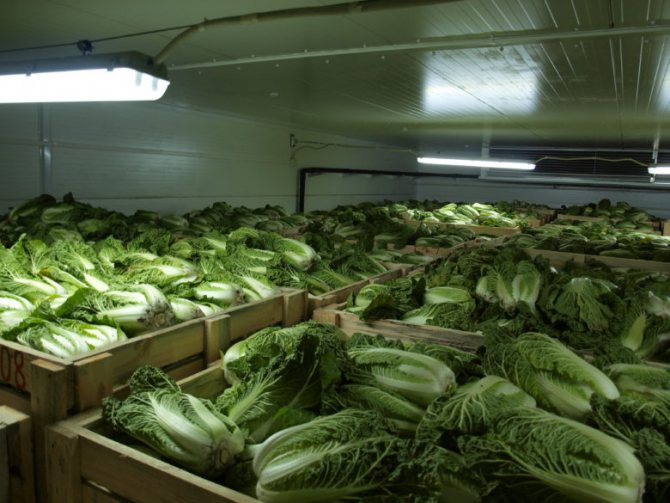

Storage of Chinese cabbage in bulk in an equipped underground
If your balcony cannot be as humid as your basement or cellar, choose storage methods that keep the leaves from drying out. For example, you can wrap the heads of cabbage in cling film, paper or dipped in clay solution (consistency of 15% sour cream).
If you leave long stalks, then the cabbage can be saved by sticking it into buckets / boxes filled with sand or soil. The heads of cabbage should not come into contact with each other in order to avoid decay. Also, periodically inspect vegetables to remove spoiled leaves.
In the attic
This method ensures the storage of cabbage in winter only where the temperature does not drop below 6-10 ° C in cold weather. Partially the heat will be transferred from the house, therefore, in the unheated attic, despite the cold outside the window, the optimal temperature for storing vegetables will remain - from 0 to -5 ° С.
On a note! If the attic is insulated, then you can save the cabbage by making it a straw shelter: below - a "pillow" of dry grass, above - a thick blanket. So the cabbage crop will easily tolerate short-term drops in temperature.
You can store cabbage in the attic in various ways: both in a suspended state, on a rope under the ceiling, and in boxes or on equipped racks.
In a refrigerator
Small amounts of cabbage, tightly wrapped with cling film, can also be stored in the refrigerator. Some housewives keep the harvest in this way for several months. The only problem is small amounts of storage. Also, periodically inspect the heads of cabbage for condensation and remove spoiled leaves.
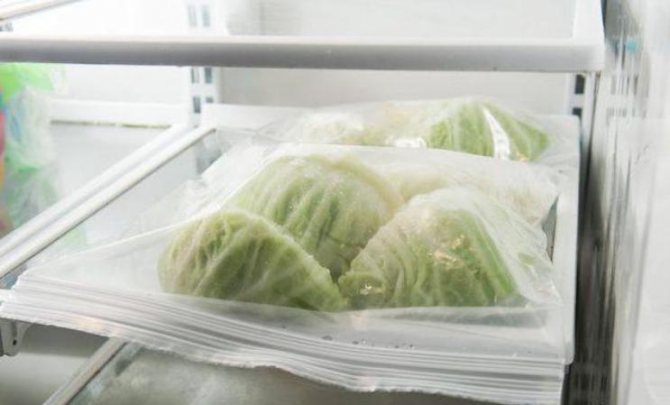

Refrigerated vegetables are stored in lower drawers or in the "fresh zone"
It is better to store fresh vegetables in the refrigerator in a special section, setting the minimum temperature. For these purposes, modern refrigerators have a so-called "fresh zone", which creates an optimal storage regime for cabbage.
Can I store?


You can store cabbage in cling film, but this method is not always applicable... For example, this method is not suitable for long-term storage.
If the product stays in the stretch for more than 4 months, it will start to deteriorate.
Wrapped in polyethylene, both whole and cut into 2 parts forks... The halves are used in the first place, since a violation of the integrity of the vegetable leads to the settling of microbes on its surface.
Therefore, after 10-15 days, it will start to deteriorate. Whole cabbages last longer.

